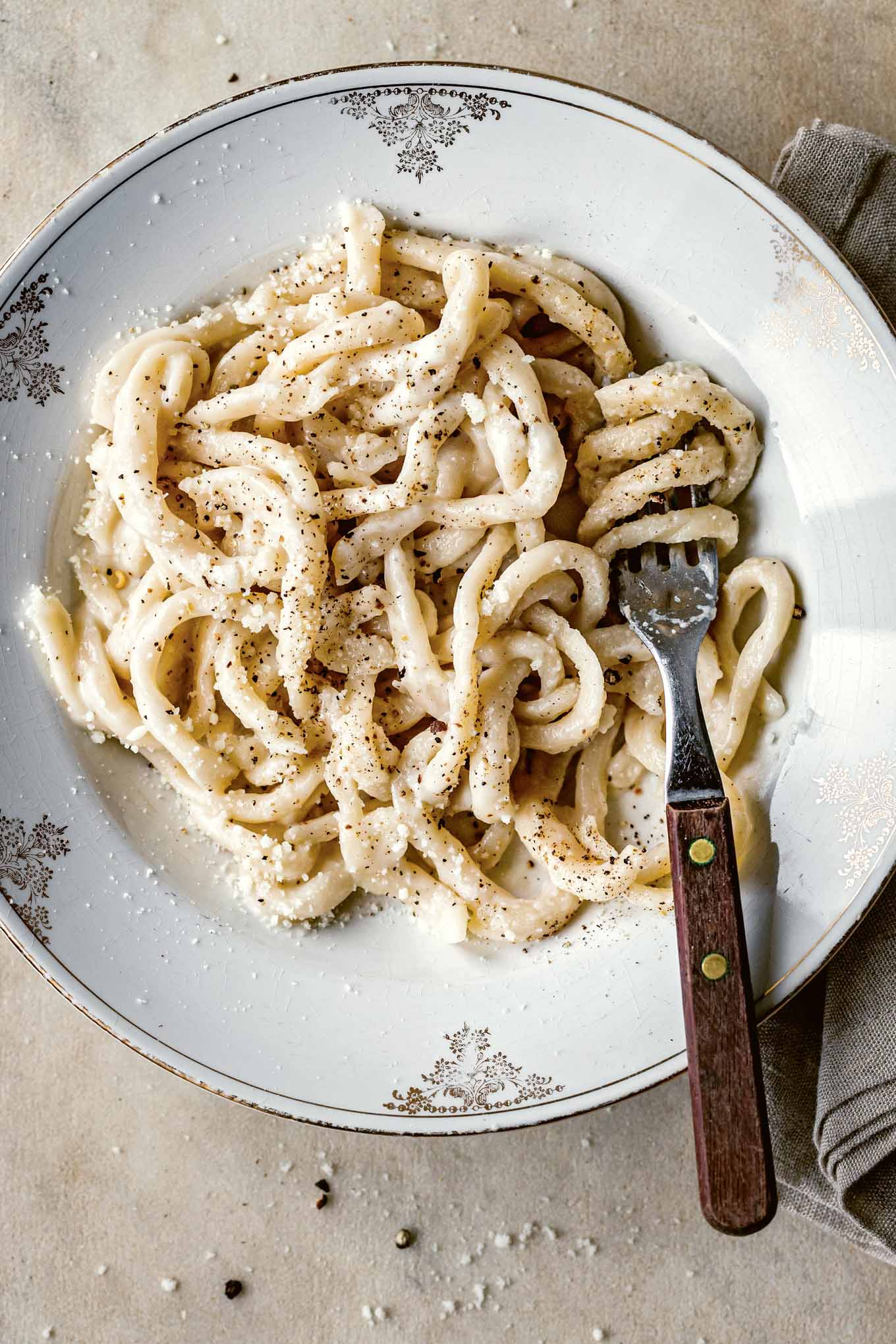
Words by Giulia Scarpaleggia. Photograph by Tomasso Galli.
Cacio e pepe is one of the primary reasons for making a gastronomic pilgrimage to Rome—along with eating carbonara, amatriciana, and gricia, the other hearty pasta dishes that are the main attraction in local trattorias. Cacio e pepe, an iconic pasta dish with a creamy Pecorino Romano and black pepper sauce, is quick to prepare, but don’t be fooled by its simplicity: timing and precision make the difference between a perfectly executed dish and a pile of pasta with congealed cheese. The quality of the ingredients is important too, as all you need for the sauce is pecorino cheese and black pepper. A half a cup of the pasta cooking water, rich in starch from the pasta, and energetic stirring give the sauce the proper creamy consistency.
As a variation from the Roman tradition, where cacio e pepe is made with bucatini or rigatoni, I like to make cacio e pepe with pici, a thick hand-pulled pasta typical of Val d’Orcia and Val di Chiana in southern Tuscany.
If you don’t want to make your own pici, opt for store-bought fresh pasta, such as tonnarelli, or high-quality dried pasta such as bucatini, spaghetti, spaghetti alla chitarra, or rigatoni. Avoid fresh egg pasta like tagliatelle or tagliolini, which would be too heavy for the cacio e pepe sauce.
Read more about Giulia in our Tastemaker interview here. Don’t miss out on “Cucina Povera” by Giulia Scarpaleggia, a collection of authentic, heartwarming Tuscan dishes. Get your copy here.
Pici Cacio e Pepe: Hand-Pulled Pici Pasta with Cheese and Black Pepper
Ingredients
- 3¼ cups 400 g all-purpose flour
- ¾ cup plus 2 Tablespoons/200 ml water
- 1 tablespoon extra-virgin olive oil
- 1 teaspoon fine sea salt
- 3 tablespoons semolina flour, plus more for dusting
- ¼ cup 35 g cornmeal
- extra-virgin olive oil for brushing
- 2 teaspoons whole black peppercorns, or more to taste
- 5 oz 140 g Pecorino Romano, grated
Instructions
- Make the pici: Pour the flour onto a work surface and shape into a mound with a large well in the center. Add the water, olive oil, and salt to the well and, using a fork, stir slowly to incorporate the water and oil, starting from the center and gradually picking up more flour from the edges. When the dough turns crumbly, switch to kneading with your hands. You want to knead the dough until it forms a ball, the gluten starts to develop, and the dough feels elastic. Continue kneading until you have clean hands and a clean board and the dough is smooth, silky, matte white, and no longer sticky, about 15 minutes. It should spring back when pressed. If it is too stiff, add water a few drops at a time and knead it in.
- Alternatively, you can make the dough in a stand mixer fitted with the dough hook. Knead for about 5 minutes on low speed, then turn it out and finish kneading by hand for about 5 minutes.
- Cover the dough with an upturned bowl and let rest for 30 minutes.
- In a medium bowl, stir together the semolina and cornmeal. Dust a rimmed baking sheet with semolina flour and set nearby.
- On a clean work surface, with a rolling pin, roll out the dough into a ¼-inch-thick/6 mm round. Brush the dough with olive oil to keep it from drying out while you make the pici. Using a pizza cutter or a very sharp knife, cut the dough into strips about ¼ inch/6 mm wide. With one hand, hold each strip down on one end and, using the other hand, roll and pull the strip into the pici shape (like thick, chubby spaghetti), drop the pici into the semolina-cornmeal mix, and then coil the noodle around your hand and place on the prepared baking sheet. Repeat with the remaining dough.
- Make the cacio e pepe: In a small frying pan, toast the peppercorns over medium heat for a few minutes, until you start smelling their pungent aroma. Transfer the peppercorns to a mortar and pound with the pestle until finely ground.
- Transfer the pepper to a large bowl and stir in the pecorino.
- Bring a large pot of water to a rolling boil and salt it lightly. Add the pici and cook for 5 to 6 minutes, until just al dente. Pici have a dense, chewy texture; do not overcook them. Just before the pici are done, scoop out ½ cup/120 ml of the pasta water, add it to the bowl with the pecorino and pepper, and stir with a wooden spoon to form a thick paste.
- Scoop out another ½ cup/120 ml of the pasta water, then drain the pici, transfer them to the bowl, and toss energetically with the sauce, adding some of the reserved cooking water if needed and tossing to perfectly emulsify the sauce, until it thoroughly coats the pici. Serve immediately, as the cheese tends to cool and set quickly.
Notes
Excerpted from Cucina Povera by Giulia Scarpaleggia (Artisan Books). Copyright © 2023. Photographs by Tomasso Galli.